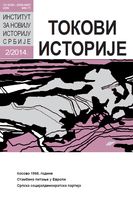Злоупотребе статуса „заштићеног станара“ у југоисточној и источној средњој Европи, 1918–1928.
Abuses of the Protected Tenant Status in East-Central and Southeast Europe, 1918–28
Author(s): Aleksandar R. MiletićSubject(s): History
Published by: Institut za noviju istoriju Srbije
Keywords: housing policy; misuses; rent control system; requisitioning; tenant protection; subtenant; sub tenancy
Summary/Abstract: Given the wartime and immediate post-war circumstances, there was a huge necessity for and a great social benefit from housing measures from the point of view of the state. On the other hand, a prolonged period of their application caused some anomalies and deviations from the basic principles for the realization of which they were put in practice. A widespread practice of subletting rooms and premises abiding by market rules was probably one of the most obvious deviations from the spirit of the tenant-protection scheme in all four countries. While the tenancy relations were under the strict control of housing regulations, sub tenancy was either left without any restriction, or these were violated in practice. Тhe practice of subletting housing units proved to be quite a lucrative business for “protected tenants” in all the four countries under review. The amount of rent collected from a subtenant for only one sublet room was usually two or three times, and sometimes up to four times, higher than what was supposed to be paid to the owner for the whole apartment. As time went by, these deviations became ever more apparent in the everyday modus operandi of the housing authorities and in communication and relationships between landlords, tenants, and subtenants. The initial housing regulations “on tenant protection” were set in motion under the assumption that tenants were economically weaker – especially when most of men were conscripted or out of a job – and thus ought to be protected from landlords. However, after a long-term application of the policy, in many instances it became quite difficult to distinguish between “economically week” and “economically strong” parties involved and to judge who really needed the protection of the state. Overall state intervention in the housing market and the creation of the rent control system, however, was not capable of replacing the basic mechanisms of supply and demand in the housing market, which continued functioning within the framework of the illegal trafficking of housing tenancy rights.
Journal: ТОКОВИ ИСТОРИЈЕ
- Issue Year: 2014
- Issue No: 2
- Page Range: 33-46
- Page Count: 14
- Language: Serbian

